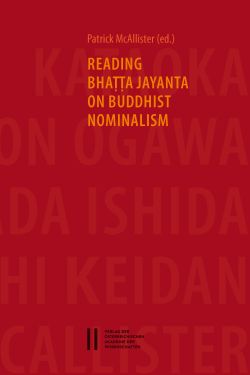
Das Buch „Reading Bhaṭṭa Jayanta on Buddhist Nominalism“ beschäftigt sich mit einer philosophischen Theorie aus dem alten Indien, der sogenannten apoha-Theorie, die von Buddhisten ungefähr ab dem 5. Jahrhundert u. Z. entwickelt wurde. Diese Theorie versucht zu erklären, was Universalien eigentlich sind und wie sie erkannt werden können, ohne aber zu akzeptieren, dass zwei reale Dinge irgendeine substantielle Gemeinsamkeit aufweisen können. Die unterschiedlichen philosophischen Probleme, die sich aus diesem scheinbar widersprüchlichen Ansatz ergaben, beschäftigten die meisten Gruppen indischer Denker für mehr als sieben Jahrhunderte und führten dazu, dass die Buddhisten diese Theorie ständig weiterentwickelten und vertieften. „Reading Bhaṭṭa Jayanta on Buddhist Nominalism“ beginnt mit einer klaren und leicht zugänglichen Diskussion der apoha-Theorie in der Nyāyamañjarī, einem philosophischen Überblickswerk, das von dem meisterhaften Autor und gelehrten Philosophen Bhaṭṭa Jayanta verfasst wurde, dessen floruit gegen Ende des 9. Jahrhunderts u. Z. lag. Diese Diskussion wird im ersten Teil des Buches in einer kritischen Edition des betreffenden Abschnittes und seiner annotierten Übersetzung ins Englische vorgestellt. Dies ermöglicht eine direkte und fundierte Einführung der apoha-Theorie in einer historisch gesicherten Form. Der zweite Teil des vorliegenden Buches bespricht in sieben Artikeln wichtige Probleme der buddhistischen Universalientheorie, die in den Bereichen der Ontologie, Epistemologie und Linguistik liegen und allesamt von Jayanta in der Nyāyamañjarī angesprochen wurden. Die Beiträge versuchen diese Fragen mittels unterschiedlicher methodologischer Ansätze zu lösen und bedienen sich dafür einer historisch-kritischen bis hin zu einer spekulativ-philosophischen Zugangsweise. Die Aufsätze sind, so wie Jayantas eigene Abhandlung, dem Zeitpunkt ihres Gegenstandes entsprechend angeordnet, wodurch Schlaglichter auf einzelne Episoden im historischen Fortschritt der apoha-Theorie vom 5. bis zum 11. Jahrhundert geworfen werden. Die besondere Kombination eines wichtigen Primärtextes mit wissenschaftlichen Artikeln, die einige der in dem Text angesprochenen Themen erforschen, soll es einerseits informierten Leserinnen und Lesern ermöglichen, diesen hochinteressanten Abschnitt der Philosophiegeschichte detailliert kennenzulernen, und andererseits der Forschungsgemeinschaft neue Erkenntnisse zu eben diesem Abschnitt bieten.
…
Reading Bhaṭṭa Jayanta on Buddhist Nominalism engages with an ancient Indian philosophical theory, called the “exclusion theory” (apoha), which was developed by Indian Buddhists from the fifth century of the common era onward. This theory attempts to explain what universals really are and how they are known, yet without accepting that any two real things are identical with each other, or even similar to each other, in any substantial sense. The manifold philosophical problems arising from this seemingly self-contradictory position, and the Buddhist’s ingenious solution to it, exercised most schools of Indian thought for more than seven centuries and caused the Buddhists to continuously refine their theory. The book bases its investigation of the apoha theory on the succinct and accessible discussion of it found in the Nyāyamañjarī, a text by the accomplished author and Nyāya philosopher Bhaṭṭa Jayanta who flourished late in the ninth century of the common era. In its first part, the book presents a careful edition of the original Sanskrit text of this section of the Nyāyamañjarī, along with a clear and annotated English translation of this text, and thus enables the reader to gain a first-hand experience of the topic in a concrete historical form. The second part of this book contains seven articles that discuss important issues that the Buddhist theory of universals had to deal with, including ontological, epistemological and linguistic conundrums, all of which are discussed in Jayanta’s text. These contributions try to answer these questions with different methods, ranging from a critical-historical analysis to the speculative philosophical approach, and often combining them for best results. These articles are arranged according to the date of their main subject matter, structurally following the presentation which Jayanta himself chose, and shine spotlights on stages of the apoha theory’s development from the fifth to eleventh century of the common era. This combination of a complete primary text with scholarly articles exploring several of its topics in more depth is intended to allow the informed reader to approach this important episode in the history of philosophy in an engaging and methodically sound manner, and to present new insights into the history of the apoha theory to the scholarly community.
2017,
978-3-7001-7974-0
978-3-7001-8244-3
321 Seiten,
22,5x15cm, broschiert